Backstage with Matthew: The weird and wonderful crafts in Rusalka

Rusalka is in the family of stories linked to The Little Mermaid — a fairy tale full of yearning, impossible love and the clash of two very different worlds. It will be told in a gorgeous production by Sir David McVicar, with debuting conductor Eun Sun Kim on the podium, and an extraordinary cast.
As in many fairy tales, the weird and the wonderful abound! We are in the world of water sprites, witches and gnomes, as well as the elegant world of the prince. It’s the kind of production that calls for particularly specialized technical skills, and a great showcase for our phenomenal Senior Crafts Artisan, Jersey McDermott.

Crafts are a very specialized part of the costume department at the Opera. If it’s worn by an artist but is not a piece of clothing, then it likely falls under Jersey’s purview. Think masks, armor, jewelry, sword sheathes, belts, etc. A vast array of items that require a vast array of skills, all focused in one person!
The water gnome in Rusalka, Vodnik, has some rather unusual appendages — large, otherworldly hands and feet. Enter Jersey! When the production was originally created in Chicago, these appendages were made from silicone, molded directly from the singers’ own hands and feet. Silicone has a translucence to it that allows it to feel very skin-like, but the challenge is that once molded, it cannot be changed, and cannot be easily repainted. You can get a sense of the silicone in the witch Jezibaba’s fingers, which we are able to repurpose for this production.
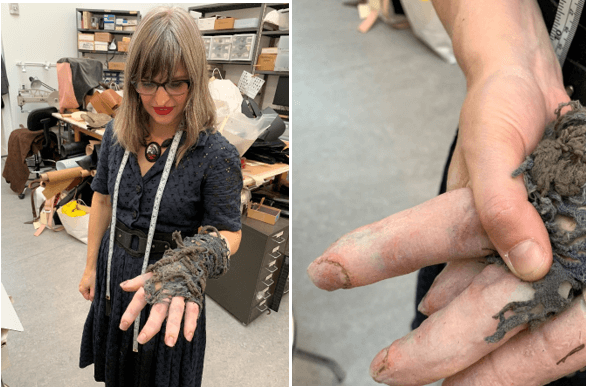
After receiving the original prosthetics from Chicago in December, Jersey ruminated over possibilities, knowing that she would need to find a more versatile solution without having access to our Vodnik, Kristinn Sigmundsson, in advance. She came up with a latex solution. Latex is much more malleable than silicone. She can create the appendages and then refine them by cutting and patching them once she’s fitted them onto Kristinn, as well as painting them to match his exact skin tone. And she has to make four sets: rehearsal and performance sets for Kristinn, and then the same for the cover Vodnik. Finding a solution that was more replicable was also helpful.
Jersey began by sculpting the appendages out of clay, utilizing the Chicago hands and feet as a basis. She then created a two-piece mold and filled the molds with latex. After drying for a few days, she could then peel off the latex casts, cut off the edges, and create the final versions. The two singers are of similar enough size that she was able to use the same mold. The downside of the latex is that it doesn’t have the translucence of silicone and so Jersey is now experimenting with paint applications that will give it a similar skin-like feel.
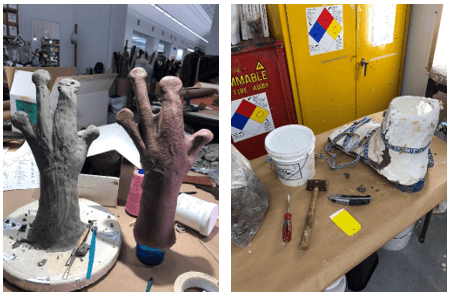
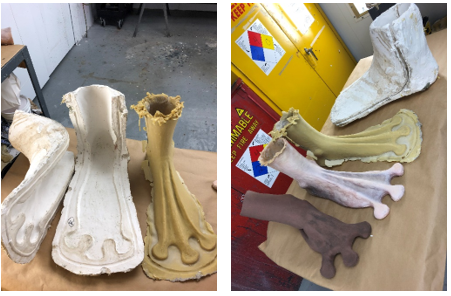
These latex appendages highlight one of the amazing things about Jersey — her ability to quickly assimilate new techniques as they become necessary. Every show brings different challenges, requires different items, and calls on different techniques. Jersey hadn’t done a lot of latex molding before, but immersed herself in the process, did a trial mold, and then launched into the creative process. She is always expanding an already vast skill set, using places like Douglass & Sturgess in San Francisco and The Crucible in Oakland as resources, and comparing ideas with colleagues around the world. Jersey is constantly problem solving, working out the best approach to build, to recreate, and to repair items with skills that range from metalworking to sewing to painting to sculpting and beyond.
She tells me that she fell into this world somewhat by chance. She has a Master in Museum Studies and was heading in that direction, but was making and selling her own jewelry and hats on the side. When she moved out to San Francisco, she had a friend who was a hat-maker at the Opera, and he encouraged her to come and work in the crafts department for Parsifal in 2000. Jersey stayed and celebrates her 20th year with us next year.
While there used to be two crafts people at the Opera, she is now the only one. She also works on many of the shoes that come through the company, repairing and altering shoes, as well as rubberizing the soles of every shoe that goes on stage for safety. She shows me a unique sewing machine — “The Patcher” — which allows you to slide on a boot and stitch it at any angle with a swiveling needle.
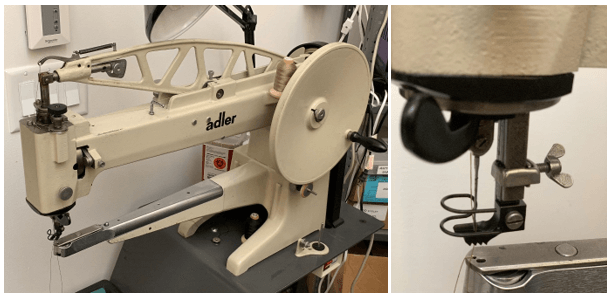
Jersey must have one of the most fascinating workstations at the Opera. It is full of unique machines with another being a “kick-press” that allows Jersey to quickly punch holes in leather and set eyelets in shoes and grommets in belts. As well as the machines, there are boxes upon boxes of supplies – glitter, glass stones, clothes pins and drawers and drawers of eyelets, hooks, grommets and snaps. It’s a treasure trove of possibility!


By the way, Jersey has continued her love of jewelry making and our Opera Shop carries a line of her jewelry modelled on the chandelier in the Opera House — they are exquisite pieces and wonderful connections to our theater.

But back to the weird and wonderful things in Rusalka. Three of the male dancers have crows’ costumes with spectacular masks and wings. The items that we’ll use in performance came with the show from Chicago and Jersey doesn’t need to recreate those (although she’d be very capable of doing so!). These are exquisite items, designed by the costume designer Moritz Junge, and you don’t want to use them in rehearsals. But, you do need to give the dancers a sense of what it will feel like to dance in the masks, and find enough space around each other while wearing the wings. (We had a similar need in Roberto Devereux last year when the dancers had fairy wings and needed rehearsal options.)
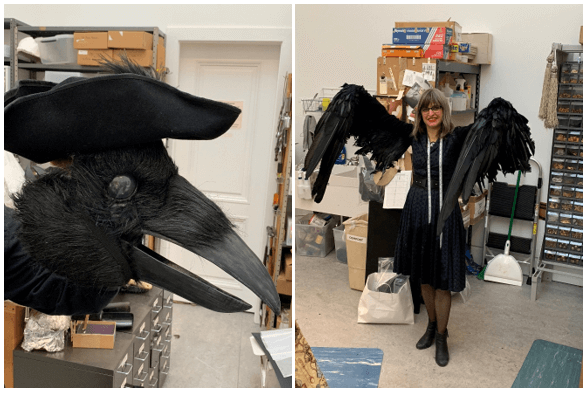
It’s quite common for Jersey to create rehearsal pieces that approximate the shape and feel of the originals, but that can be used much more routinely in rehearsals. So she set to work designing and creating rehearsal masks and wings. The masks are made out of cardboard, ingenuously crafted out of just a few pieces, folded in just the right way to create the correct shape. Inside are supports to keep the mask in place on the face, made out of thermoplastic which Jersey heated and molded over a head-block to get the right shape.
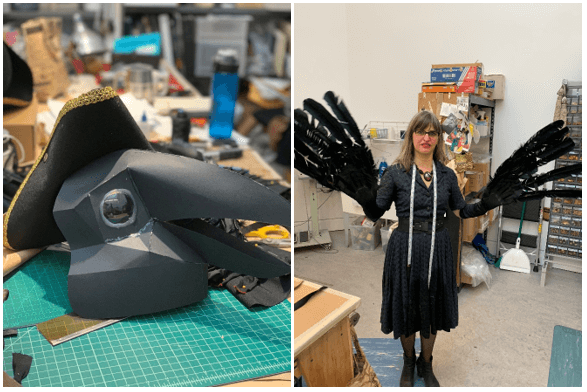
The rehearsal wings are also ingenuous. Long black gloves, with some basic feathers attached to the end. Just enough to give the dancers the sense of dancing with wings, without having to recreate the originals. Once again, this is all ingenious problem solving. There are no guides or how-to manuals for most of what Jersey does. It’s bringing together 20+ years of expertise in so many areas, and figuring out each situation as it arises.
Rusalka is definitely one of the more crafts-intensive shows this summer. Orlando, as a more contemporary production, doesn’t have a heavy crafts need, and Jersey’s work in Carmen is largely focused on belts, sword sheaths and dagger holders. For example, she had to make 20 historic belts for some of the men in Carmen, cutting out the strips of leather, punching them with the afore-mentioned kick-press, and then antiquing belt-buckles using a French enamel varnish created by our dyer, Amy Van Every — a mixture of leather dye, denatured alcohol, and shellac. These are the kinds of historic belts that are impossible to buy in the number we need, and so need to be made. But, as with other aspects of our work like the male hats in Tosca, when we can source commercially we do. The pieces needed for Appomattox, for example, were largely able to be sourced commercially, given the number of Civil War reenactment suppliers. It’s always a blend of what can we buy, what can we repurpose and what needs to be made afresh.

As weird and wonderful as the crafts are in Rusalka, they don’t come close to what was probably Jersey’s magnum opus so far: Dream of the Red Chamber. Jersey had to craft 18 suits of armor with each costume having 8 separate pieces that had to be sculpted, molded, cast, vacuformed and painted. The helmets alone were made up of 3 separate pieces, and then there were shoulder pieces, knee and leg pieces, breastplates, tabs, belt buckles. And she only had about 6 months to work on the whole project, at the same time as needing to work on armor in Don Carlo. Red Chamber also called on leather-working and jewelry skills — it brought together so many aspects of Jersey’s work and the results were stunning.

So, as you see weird and wonderful things as parts of costumes in Rusalka, it’s likely that they are things that passed across Jersey’s desk. Her craftsmanship, detail, and dedication are reflective of the talents we are so proud to have within the Opera family. And there is most certainly never a typical day at work for Jersey!

I’m very excited to share with you our summer season and look forward to welcoming you back to the Opera in just a few weeks’ time!

